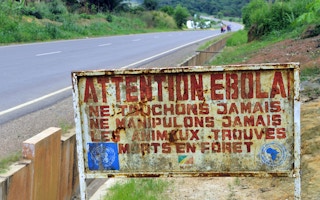Which countries, beyond those in West Africa, are most susceptible to the Ebola epidemic? Most epidemiologists do not fear much for the developed world, with its effective quarantine measures and tracking procedures, or even for sparsely populated developing countries. An outbreak could easily be contained in both groups of countries. But large, densely populated areas, lacking the proper containment mechanisms are highly vulnerable.
To continue reading, subscribe to Eco‑Business.
There's something for everyone. We offer a range of subscription plans.
- Access our stories and receive our Insights Weekly newsletter with the free EB Member plan.
- Unlock unlimited access to our content and archive with EB Circle.
- Publish your content with EB Premium.
India, with its large emigrant population (the second largest in the world), high urban density, and inadequate public health-care infrastructure, potentially has the most to lose if the Ebola virus spreads. Links to West Africa are close and go back over the last century, with almost 50,000 Indians or people of Indian origin living in the region.
Indeed, scores of people fly between Accra, Lagos, Freetown, Monrovia, or Abidjan and New Delhi, Mumbai, Calcutta, or Chennai on a daily basis, transiting through the Middle East or Europe. While exit controls are in place in all of the international airports in the affected regions, the virus’s incubation period (which averages eight days in the current outbreak but can be up to 21 days) means that someone with no symptoms from a recent infection could make the trip to India without triggering alarms.
Recent personal experience at New Delhi airport indicated that nominal arrival checks, as the government requires, were loosely enforced, with a number of passengers exiting the terminal holding completed Ebola information cards that should have been handed to immigration officials. It seems unlikely that India’s government will be able to keep tabs on all of the arrivals from West Africa.
Population density in India’s mega-cities is as high as 10,000 people per square kilometer, and can match that level even in second- and third-tier cities, as slums mushroom to accommodate large-scale migration from rural areas. Spending on health-care infrastructure has been woefully inadequate, failing to keep pace with burgeoning urban populations.
Outside of the large cities, most health-care facilities are unable to provide anything more than primary care. World Bank data show that India currently has 6.5 doctors, 13 nurses, and nine hospital beds per 10,000 people – levels that are less than half the global average and far below what the World Health Organization recommends.
Given these factors – urban density, congested slums and shantytowns with poor sanitation, drainage, and sewage, and weak health-care infrastructure – it is easy to imagine how the Ebola virus could spread rapidly. A single infected person who arrives from West Africa and is then untraceable could easily trigger an epidemic.
“
The current Ebola epidemic in West Africa reflects a fundamental ecological imbalance. A virus that previously infected the fruit bat has crossed over to humans, whose population growth and density is at odds with the support that the natural environment can provide.
India’s government insists that it is prepared. But, with limited resources and equipment and poorly trained medical support staff outside of the large metropolitan areas, it is easy to imagine the disease hitting health workers, as recent cases in Madrid and Dallas – not to mention West Africa – demonstrate. Indeed, because Ebola presents symptoms similar to malaria, dengue fever, and other endemic tropical diseases, medical workers may not take adequate precautions – or, worse, may send patients home in a highly contagious phase.
The government’s options are limited. The health-care system faces deeper systemic challenges that cannot be addressed overnight or only in response to Ebola. What the authorities can do is improve their tracking of all passengers arriving from West Africa, just as the United States and the United Kingdom have begun to do.
Ideally, all passengers arriving from the region would be quarantined on arrival and monitored for symptoms for at least eight days. But that would be unfair, and the government’s capacity to implement such a program across all of India’s international airports and seaports is dubious.
Instead, all arriving passengers from West Africa need to be alerted to the symptoms of the disease, instructed how to monitor themselves, and made aware of the importance of seeking medical attention at the first sign of illness. Moreover, it is essential to educate health-care workers in all urban areas about the virus and its symptoms, and to train them to ascertain patients’ medical and travel history.
The current Ebola epidemic in West Africa reflects a fundamental ecological imbalance. A virus that previously infected the fruit bat has crossed over to humans, whose population growth and density is at odds with the support that the natural environment can provide. That imbalance is hardly unique to Guinea, Liberia, and Sierra Leone.
While it is probable that Ebola will surface in India in the near future, an adequate response is possible, as Nigeria has shown. Lagos, where the Nigerian authorities have done a remarkable job of preventing the spread of the virus, closely resembles India’s megapolises. India’s government should take note.
Hrishabh Sandilya is a lecturer on South Asian politics at Charles University in Prague. Dany Shoham is a senior researcher at the Begin-Sadat Center for Strategic Studies, Bar Ilan University, Israel. They are Visiting Fellows at the Institute of Defense Studies and Analyses (IDSA) in New Delhi. This article is republished from Project Syndicate, Copyright Project Syndicate 1995–2014











